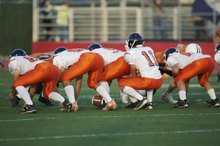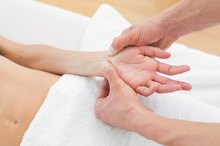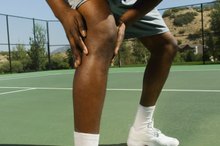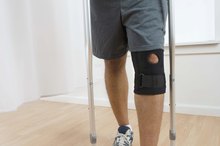How to Rehab a Torn Meniscus
A meniscus is a wedge-shaped piece of rubbery cartilage that sits between the bones in your knee joint. Each knee has two menisci, which help stabilize the knee, absorb shock and prevent the femur, tibia and kneecap bones from rubbing against one another. If the knee joint twists or rotates excessively, the meniscus can tear. A torn meniscus often causes pain, swelling, instability and stiffness near the knee joint. Although you will likely be able to walk on the injured knee, the symptoms will become increasingly worse until the injury is allowed to rest and heal.
Diagnosis
A torn meniscus is often diagnosed through a physical examination or imaging test. With a physical examination, the doctor might gently palpate the area around the knee joint to test for tenderness. A physical examination might also utilize the McMurray test, one of the most common tests for meniscus tears, according to the American Academy of Orthopaedic Surgeons. For this test, the doctor will gently bend, straighten and rotate your knee. If the meniscus is torn, a clicking sound can usually be heard as the knee is moved. An MRI imaging test can also be used to confirm the diagnosis.
- A torn meniscus is often diagnosed through a physical examination or imaging test.
- With a physical examination, the doctor might gently palpate the area around the knee joint to test for tenderness.
Surgical Treatment
Pain in the Knee & Occasional Popping When Walking
Learn More
The exact treatment required for a torn meniscus depends on the location and extent of the injury. The outside portion of the meniscus benefits from a rich blood supply -- small tears that occur in this area often heal without surgical treatment. Extensive tears in this area are often corrected through arthroscopic surgical treatments. Tears that occur along the inner 2/3 of the meniscus are significantly more difficult – if not impossible – to correct. Since this area lacks an abundant blood supply, the tissues cannot heal properly. In this case, a doctor can only surgically trim away torn pieces. After surgery, your doctor will likely apply a cast or brace, which prevents movement and allows for proper healing.
- The exact treatment required for a torn meniscus depends on the location and extent of the injury.
- The outside portion of the meniscus benefits from a rich blood supply -- small tears that occur in this area often heal without surgical treatment.
Nonsurgical Treatment
If your meniscus tear was not severe enough to require surgery, your rehabilitation should simply involve rest, ice, compression and elevation. Rest your knee for the length of time recommended by your physician, avoiding any activities that could potentially aggravate the injury. Unless otherwise directed, apply ice to the area for 20 minutes every two hours. The cold helps reduce swelling and pain, but be sure to wrap the ice pack in a towel to avoid injury to the skin. An elastic bandage wrapped tightly around your knee can help stabilize the knee joint and reduce swelling. While resting, keep your knee elevated higher than your heart to further reduce swelling.
- If your meniscus tear was not severe enough to require surgery, your rehabilitation should simply involve rest, ice, compression and elevation.
- An elastic bandage wrapped tightly around your knee can help stabilize the knee joint and reduce swelling.
Rehabilitation
Signs of a Torn MCL So You Know to See a Doctor
Learn More
Your physician will likely recommend a series of exercises to help restore mobility and improve strength. A rehabilitation program generally begins with range of motion exercises, which require you to gently move the knee back and forth to reestablish movement. As your knee stability improves, strengthening exercises will also be added to your rehabilitation routine. Your physician or physical therapist will recommend appropriate exercises for your specific condition.
- Your physician will likely recommend a series of exercises to help restore mobility and improve strength.
Related Articles
References
- MayoClinic.com; Torn Meniscus; February 2011
- American Academy of Orthopaedic Surgeons; Meniscal Tears; February 2009
- The Ohio State University Medical Center: Torn Meniscus
- Cigna; Meniscus Tear: Rehabilitation Exercises; September 2010
- The Stretching Institute; Meniscus Tear and Torn Knee Cartilage; Brad Walker
- Meniscus Tears. American Academy of Orthopaedic Surgeons. https://orthoinfo.aaos.org/en/diseases--conditions/meniscus-tears.
- Torn Meniscus. Mayo Clinic. https://www.mayoclinic.org/diseases-conditions/torn-meniscus/symptoms-causes/syc-20354818.
- Van de graaf VA, Noorduyn JCA, Willigenburg NW, et al. Effect of Early Surgery vs Physical Therapy on Knee Function Among Patients With Nonobstructive Meniscal Tears: The ESCAPE Randomized Clinical Trial. JAMA. 2018;320(13):1328-1337. doi:10.1001/jama.2018.13308
- Katz JN, Brophy RH, Chaisson CE, et al. Surgery versus physical therapy for a meniscal tear and osteoarthritis. N Engl J Med. 2013;368(18):1675-84.
- Katz JN, Wright J, Spindler KP, et al. Predictors and Outcomes of Crossover to Surgery from Physical Therapy for Meniscal Tear and Osteoarthritis: A Randomized Trial Comparing Physical Therapy and Surgery. J Bone Joint Surg Am. 2016;98(22):1890-1896.
- Van de graaf VA, Noorduyn JCA, Willigenburg NW, et al. Effect of Early Surgery vs Physical Therapy on Knee Function Among Patients With Nonobstructive Meniscal Tears: The ESCAPE Randomized Clinical Trial. JAMA. 2018;320(13):1328-1337.
Writer Bio
Krista Sheehan is a registered nurse and professional writer. She works in a neonatal intensive care unit (NICU) and her previous nursing experience includes geriatrics, pulmonary disorders and home health care. Her professional writing works focus mainly on the subjects of physical health, fitness, nutrition and positive lifestyle changes.








